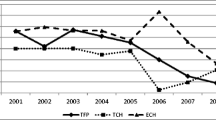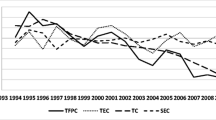Abstract
Assessing productivity change over time and identifying its determinants is a valuable tool for water regulators when setting water tariffs. However, in a price cap regulatory framework such as in England and Wales policy makers should give attention to quality of service issues. Previous studies that assessed the productivity change of the English and Welsh water industry did not include the lack of quality of service to customers as undesirable outputs. To overcome this limitation, and as a pioneering approach, we estimated the Malmquist-Luenberger Productivity Indicator and its components, efficiency and technical change, for the 10 water and sewerage companies and the 12 water only companies over the period 2001–2008. To explore the role of quality of service to customers on the productivity change over time, we contrasted our results with a conventional measure of productivity change namely the Luenberger productivity indicator. The findings suggest that from 2001 to 2004 water companies made significant efforts to improve the quality of the service provided to customers, whereas after 2005 companies’ performance regarding customer services was considered as poor. Results excluding quality of service variables illustrated that productivity declined during all years evaluated. However, when the quality of service was introduced in the assessment, productivity improved by 4.13 % from 2000 to 2004 whereas it declined by 16.96 % in the following years. From a policy perspective, water utility regulators need to pay attention to quality of service issues when assessing companies’ performance and setting water tariffs under comparative yardstick regimes.




Similar content being viewed by others
Notes
The study by Molinos-Senante et al. (2014) provides additional information and details about the drivers of the productivity change when it is computed using the LPI.
References
Ali MK, Klein KK (2014) Water use efficiency and productivity of the irrigation districts in southern Alberta. Water Resour Manag 28(10):2751–2766
Ananda J, Hampf B (2015) Measuring environmentally sensitive productivity growth: an application to the urban water sector. Ecol Econ 116:211–219
Arabi B, Munisamy S, Emrouznejad A, Shadman F (2014) Power industry restructuring and eco-efficiency changes: a new slacks-based model in Malmquist-Luenberger index measurement. Energy Policy 68:132–145
Balk BM (2001) Scale efficiency and productivity change. J Prod Anal 15(3):159–183
Barros C, Antunes OS (2014) Productivity change in the oil blocks of Angola. Energy Sources, Part B: Economics, Planning and Policy 9(4):413–424
Berg S, Lin C (2008) Consistency in performance rankings: the Peru water sector. Appl Econ 40(6):793–805
Bottasso A, Conti M (2009) Scale economies, technology and technical change: evidence from the English water only sector. Reg Sci Urban Econ 39(2):138–147
Boussemart J-P, Briec W, Kerstens K, Poutineau J-C (2003) Luenberger and Malmquist productivity indices: theoretical comparisons and empirical illustration. Bull Econ Res 55(4):391–405
Carvalho P, Marques RC (2014) Computing economies of vertical integration, economies of scope and economies of scale using partial frontier nonparametric methods. Eur J Oper Res 234(1):292–307
CCW (2014). Water Matters: Household customers’ views on their water and sewerage services 2013. Consumer Council for Water, London.
Chambers RG, Chung Y, Färe R (1996) Benefit and distance functions. J Econ Theory 70(2):407–419
Chung YH, Färe R, Grosskopf S (1997) Productivity and undesirable outputs: a directional distance function approach. J Environ Manag 51(3):229–240
Cooper WW, Seiford LM, Zhu J (2007) Handbook on data envelopment analysis. International Series in Operations Research & Management Science, Springer
Corton ML, Berg SV (2009) Benchmarking central American water utilities. Util Policy 17(3–4):267–275
Da Cruz NF, Marques RC, Romano G, Guerrini A (2012) Measuring the efficiency of water utilities: a cross-national comparison between Portugal and Italy. Water Policy 14(5):841–853
De Witte K, Marques RC (2010) Influential observations in frontier models, a robust non-oriented approach to the water sector. Ann Oper Res 181(1):377–392
Epure M, Kerstens K, Prior D (2011) Bank productivity and performance groups: a decomposition approach based upon the Luenberger productivity indicator. Eur J Oper Res 211(3):630–641
Erbetta F, Cave M (2007) Regulation and efficiency incentives: evidence from the England and Wales water and sewerage industry. Rev Netw Econ 6(4):425–452
Färe R, Grosskopf S (2004) Modeling undesirable factors in efficiency evaluation: comment. Eur J Oper Res 157(1):242–245
Färe R, Grosskopf S, Lovell CAK (1994) Production Frontiers. Cambridge University Press, Cambridge
Färe R, Grosskopf S, Roos P (1995) Productivity and quality changes in Swedish pharmacies. Int J Prod Econ 39 (1–2), 137–144
Goncalves O (2013) Efficiency and productivity of French ski resorts. Tour Manag 36:650–657
Guerrini A, Romano G, Campedelli B (2013) Economies of scale, scope, and density in the Italian water sector: a two-stage data envelopment analysis approach. Water Resour Manag 27(13):4559–4578
Hernández-Sancho F, Molinos-Senante M, Sala-Garrido R (2011) Techno-economical efficiency and productivity change of wastewater treatment plants: the role of internal and external factors. J Environ Monit 13(12):3448–3459
Hernández-Sancho F, Molinos-Senante M, Sala-Garrido R, Del Saz-Salazar S (2012) Tariffs and efficient performance by water suppliers: an empirical approach. Water Policy 14(5):854–864
Kumar S, Managi S (2010) Service quality and performance measurement: evidence from the Indian water sector. Water Resour Dev 26(2):173–191
Magee A, Counsell M. (2013). Ofwat SIM Survey 2012/13 Annual Report. Report prepared for Ofwat, Birmingham.
Marques RC (2008) Comparing private and public performance of Portuguese water services. Water Policy 10(1):25–42
Marques RC, Simoes P (2008) Does the sunshine regulatory approach work?: governance and regulation model of the urban waste services in Portugal. Resour Conserv Recycl 52(8–9):1040–1049
Maziotis A, Saal DS, Thanassoulis E, Molinos-Senante M (2015a) Profit, productivity and price performance changes in the water and sewerage industry: an empirical application for England and Wales. Clean Techn Environ Policy 17(4):1005–1018
Maziotis A, Saal DS, Thanassoulis E, Molinos-Senante M (2015b) Profit change and its drivers in the English and welsh water industry: is output quality important? Water Policy. doi:10.2166/wp.2014.151
Mbuvi D, De Witte K, Perelman S (2012) Urban water sector performance in Africa: a step-wise bias-corrected efficiency and effectiveness analysis. Util Policy 22:31–40
Molinos-Senante M, Sala-Garrido R (2015) The impact of privatization approaches on the productivity growth of the water industry: a case study of Chile. Environ Sci Pol 50:166–179
Molinos-Senante M, Maziotis A, Sala-Garrido R (2014) The Luenberger productivity indicator in the water industry: an empirical analysis for England and Wales. Util Policy 30:18–28
Molinos-Senante M, Sala-Garrido R, Lafuente M (2015) The role of environmental variables on the efficiency of water and sewerage companies: a case study of Chile. Environ Sci Pollut Res 22(13):10242–10253
Molinos-Senante M, Maziotis A, Mocholí-Arce M, Sala-Garrido R (2016) Accounting for service quality to customers in the efficiency of water companies: evidence from England and Wales. Water Policy 18(2):513–532
Molinos-Senante M, Hernández-Sancho F, Mocholí-Arce M, Sala-Garrido R (2015c) Productivity growth of wastewater treatment plants – accounting for environmental impacts: a Malmquist-Luenberger index approach. Urban Water J 13(5):476–485
Molinos-Senante, M., Maziotis, A., Sala-Garrido, R. (2016a). Estimating the cost of improving service quality in water supply: a shadow price approach for England and Wales. Sci Total Environ, 539: 470–477.
Molinos-Senante M, Maziotis A, Sala-Garrido R (2016b) Assessment of the total factor productivity change in the English and welsh water industry: a fare: Primont productivity index approach. Water Resour Manag. doi:10.1007/s11269-016-1346-2
O’Donnell CJ (2014) Econometric estimation of distance functions and associated measures of productivity and efficiency change. J Prod Anal 41(2):187–200
Ofwat (2003) Levels of service for the water industry in England & Wales 2002–2003 report. Office of Water Services, Birmingham
Ofwat (2004) Levels of service for the water industry in England & Wales 2003–2004 report. Office of Water Services, Birmingham
Ofwat (2005) Levels of service for the water industry in England & Wales 2004–2005 report. Office of Water Services, Birmingham
Ofwat (2006) Levels of service for the water industry in England & Wales 2005–2006 report. Office of Water Services, Birmingham
Ofwat (2008) Levels of service for the water industry in England & Wales 2007–2008 report. Office of Water Services, Birmingham
Ofwat (2009). Future water and sewerage charges 2010–2015; Final determinations, Office of Water Services, Birmingham.
Ofwat (2011). Water today, water tomorrow. Available at: http://www.ofwat.gov.uk/wpcontent/uploads/2015/11/prs_inf_catchment.pdf
Ofwat (2012) Service incentive mechanism – guidance for collating customer service information for calculating the SIM score. Water Services Regulation Authority, Birmingham
Ofwat (2013) Setting Price Controls for 2015–20 – Final Methodology and Expectations for Companies’ Business Plans. Water Services Regulation Authority, Birmingham
Picazo-Tadeo AJ, Sáez-Fernández FJ, González-Gómez F (2008) Does service quality matter in measuring the performance of water utilities? Util Policy 16(1):30–38
Portela MCAS, Thanassoulis E, Horncastle A, Maugg T (2011) Productivity change in the water industry in England and Wales: application of the meta- Malmquist index. J Oper Res Soc 62(12):2173–2188
Saal DS, Parker D (2001) Productivity and price performance in the privatized water and sewerage companies of England and Wales. J Regul Econ 20(1):61–90
Saal DS, Parker D, Weyman-Jones T (2007) Determining the contribution of technical change, efficiency change and scale change to productivity growth in the privatized English and welsh water and sewerage industry: 1985-2000. J Prod Anal 28(1–2):127–139
Sala-Garrido R, Hernández-Sancho F, Molinos-Senante M (2012) Assessing the efficiency of wastewater treatment plants in an uncertain context: a DEA with tolerances approach. Environ Sci Pol 18:34–44
Seiford LM, Zhu J (2005) A response to comments on modeling undesirable factors in efficiency evaluation. Eur J Oper Res 161(2):579–581
Simoes P, Marques RC (2012) Influence of regulation on the productivity of waste utilities. What can we learn with the Portuguese experience? Waste Manag 32(6):1266–1275
Tyteca D (1996) On the measurement of the environmental performance of firms - a literature review and a productive efficiency perspective. J Environ Manag 46(3):281–308
Worthington AC (2014) A review of frontier approaches to efficiency and productivity measurement in urban water utilities. Urban Water J 11(1):55–73
Yu M-M, Hsu S-H, Chang C-C, Lee D-H (2008) Productivity growth of Taiwan’s major domestic airports in the presence of aircraft noise. Transportation Research Part E: Logistics and Transportation Review 44(3):543–554
Zhou P, Zhou X, Fan LW (2014) On estimating shadow prices of undesirable outputs with efficiency models: a literature review. Appl Energy 130:799–806
Author information
Authors and Affiliations
Corresponding author
Rights and permissions
About this article
Cite this article
Maziotis, A., Molinos-Senante, M. & Sala-Garrido, R. Assesing the Impact of Quality of Service on the Productivity of Water Industry: a Malmquist-Luenberger Approach for England and Wales. Water Resour Manage 31, 2407–2427 (2017). https://doi.org/10.1007/s11269-016-1395-6
Received:
Accepted:
Published:
Issue Date:
DOI: https://doi.org/10.1007/s11269-016-1395-6




